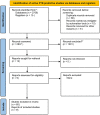Past and Present Approaches to Diagnosis of Active Pulmonary Tuberculosis
- PMID: 34631731
- PMCID: PMC8495065
- DOI: 10.3389/fmed.2021.709793
Past and Present Approaches to Diagnosis of Active Pulmonary Tuberculosis
Abstract
Tuberculosis disease continues to contribute to the mortality burden globally. Due to the several shortcomings of the available diagnostic methods, tuberculosis disease continues to spread. The difficulty to obtain sputum among the very ill patients and the children also affects the quick diagnosis of tuberculosis disease. These challenges warrant investigating different sample types that can provide results in a short time. Highlighted in this review are the approved pulmonary tuberculosis diagnostic methods and ongoing research to improve its diagnosis. We used the PRISMA guidelines for systematic reviews to search for studies that met the selection criteria for this review. In this review we found out that enormous biosignature research is ongoing to identify host biomarkers that can be used as predictors of active PTB disease. On top of this, more research was also being done to improve already existing diagnostic tests. Host markers required more optimization for use in different settings given their varying sensitivity and specificity in PTB endemic and non-endemic settings.
Keywords: biomarkers; diagnosis; immune response; immunodiagnostic assay; tuberculosis.
Copyright © 2021 Namuganga, Chegou and Mayanja-Kizza.
Conflict of interest statement
The authors declare that the research was conducted in the absence of any commercial or financial relationships that could be construed as a potential conflict of interest.
Figures


References
-
- World Health Organization . World Health Organization (WHO) Information Note Tuberculosis and COVID-19. (2020). Available online at: https://www.who.int/tb/COVID_19considerations_tuberculosis_services.pdf (accessed April 4, 2020).
-
- World Health Organisation; Stop TB Partnership . The STOP TB Strategy [Internet]. Vol. http://app, Stop TB strategy (2006). Available online at: http://apps.who.int/iris/bitstream/handle/10665/69241/WHO_HTM_STB_2006.3...
-
- World Health Organisation: End TB strategy . End TB Strategy [Internet]. Vol. 53 (2013). Available online at: https://www.who.int/publications/i/item/WHO-HTM-TB-2015.19
-
- World Health Organisation . World Health Organisation: Global Tuberculosis Report. Geneva: (2020).
Publication types
LinkOut - more resources
Full Text Sources
Miscellaneous

